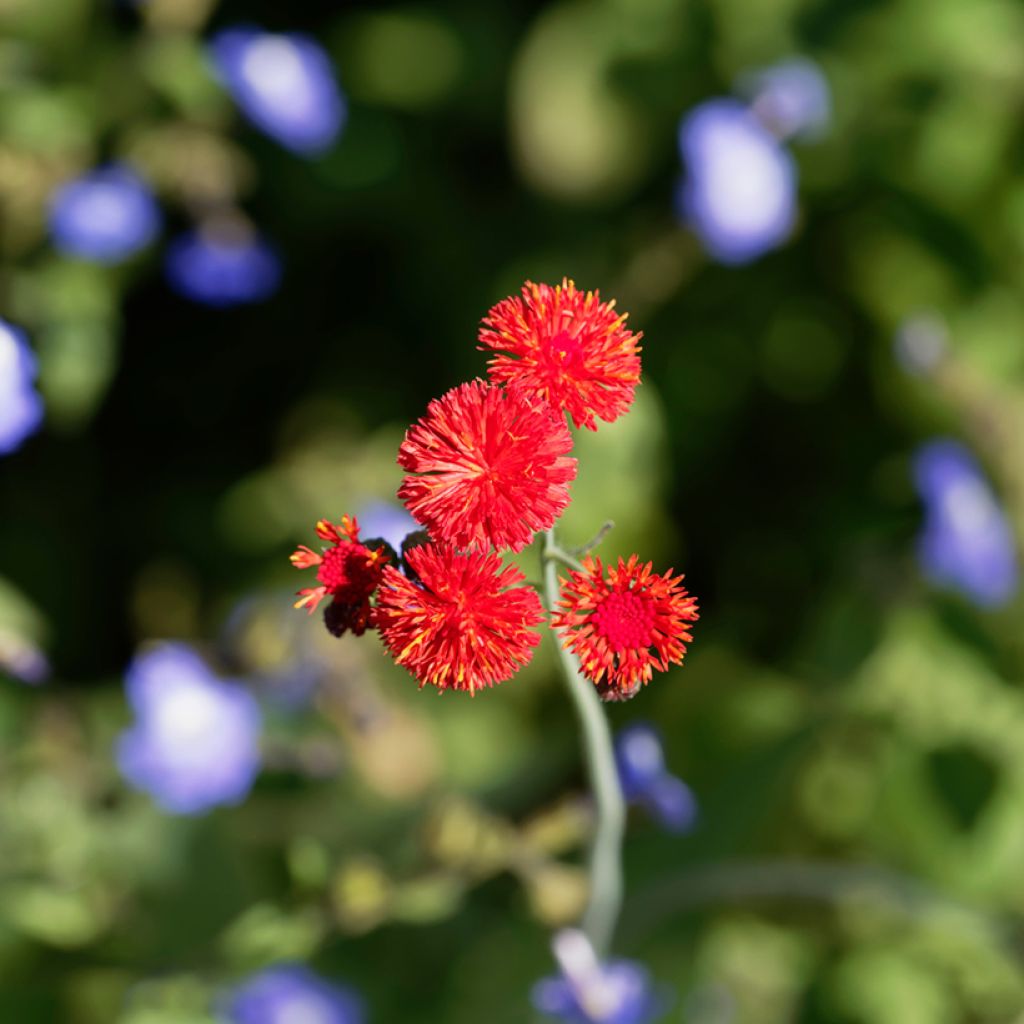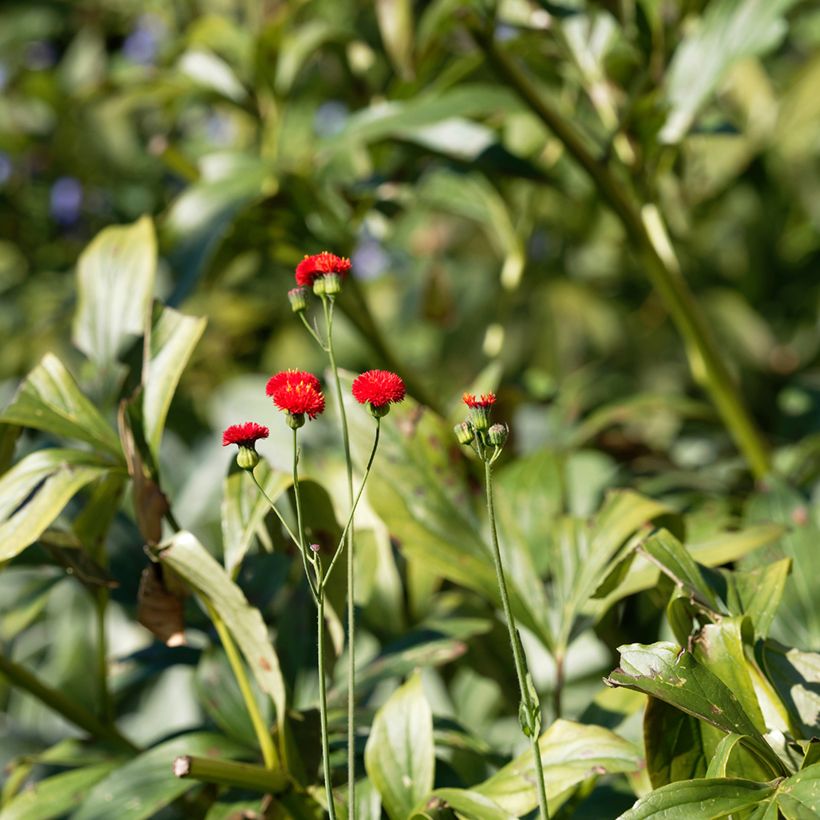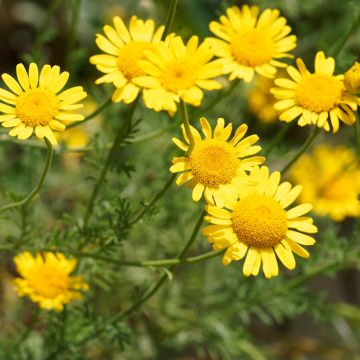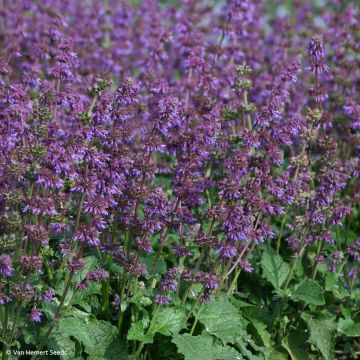

Tassel Flower Scarlet Magic Seeds - Emilia coccinea


Tassel Flower Scarlet Magic Seeds - Emilia coccinea


Tassel Flower Scarlet Magic Seeds - Emilia coccinea


Tassel Flower Scarlet Magic Seeds - Emilia coccinea
Tassel Flower Scarlet Magic Seeds - Emilia coccinea
Emilia coccinea Scarlet Magic
A translation of the notice would be a plus.
Mireille F., 27/01/2020
This item cannot be shipped to the selected country
Dispatch by letter from €3.90
More information
Schedule delivery date,
and select date in basket
This plant carries a 6 months recovery warranty
More information
We guarantee the quality of our plants for a full growing cycle, and will replace at our expense any plant that fails to recover under normal climatic and planting conditions.
Seed-only orders are dispatched by sealed envelope. The delivery charge for seed-only orders is €3.90.
Does this plant fit my garden?
Set up your Plantfit profile →
Description
Emilia coccinea Scarlet Magic is an adorable red-flowering variety of the African wildflower known as Scarlet tasselfower. In summer, its small red thistle-like flowers sway nonchalantly at the top of slender stems. With its light, airy silhouette, it is beautiful planted en masse in borders or summer bedding schemes. This annual will self-seed easily and is perfect for summer floral arrangements. It thrives in full sun and well-drained soil.
Emilia coccinea belongs to the Asteraceae family. It is an herbaceous annual, native to Central and Eastern Africa (Congo, Burundi, Sudan, Kenya, Uganda, Tanzania, Malawi, Zambia, Angola, Zimbabwe and Mozambique). It occurs naturally on roadsides and disturbed sites. 'Scarlet Magic' forms a bushy clump, made up of a rosette of bluish-green leaves and sessile leaves. It has an erect habit, growing to about 45 to 60 cm in height; the very thin stems are generally pubescent at their base, becoming smooth towards their tip. In summer, flower heads appear at the top of the stems. They are either solitary or grouped in corymbs of 2 to 6. The showy inflorescences look like small, intensely red thistles. They are followed by fruits called achenes, which are hairy seed capsules filled with seeds that germinate easily in poor soils, much like poppies.
Scarlet tasselflowers brighten up borders and flowerbeds, forming remarkable splashes of colour. 'Scarlet Magic' looks fantastic in wild, informal settings alongside catmints, pink Love-in-a-mist, California poppies, blue or purple-coloured cornflowers or ornamental grasses such as Stipa tenuifolia and Mulhenbergia capillaris.
Report an error about the product description
Tassel Flower Scarlet Magic Seeds - Emilia coccinea in pictures




Flowering
Foliage
Plant habit
Botanical data
Emilia
coccinea
Scarlet Magic
Asteraceae
Cultivar or hybrid
Other Thompson and Morgan seeds
Planting and care
Direct sow from March to May. First loosen the soil. Then scatter the seeds sparingly in furrows, about 3 mm deep. Water regularly, especially during dry spells. Thin out, leaving 20-30 cm between each plant.
Alternatively, sow in seed trays in moist sowing mix or compost. Cover with a fine layer of compost or vermiculite and keep in a light place at a temperature of 15-20°C. Keep the soil moist but not waterlogged. Germination takes 14 to 30 days. Transplant the seedlings into pots or containers. When all risk of frost is over, plant them out in a sunny location in well-drained soil. Make sure to leave 20-30 cm between each plant.
Tassel flowers thrive in full sun and well-drained soil. They self-seed easily in poor, disturbed soil.
Sowing period
Intended location
-
, onOrder confirmed
Reply from on Promesse de fleurs
Flower seeds
Haven't found what you were looking for?
Hardiness is the lowest winter temperature a plant can endure without suffering serious damage or even dying. However, hardiness is affected by location (a sheltered area, such as a patio), protection (winter cover) and soil type (hardiness is improved by well-drained soil).

Photo Sharing Terms & Conditions
In order to encourage gardeners to interact and share their experiences, Promesse de fleurs offers various media enabling content to be uploaded onto its Site - in particular via the ‘Photo sharing’ module.
The User agrees to refrain from:
- Posting any content that is illegal, prejudicial, insulting, racist, inciteful to hatred, revisionist, contrary to public decency, that infringes on privacy or on the privacy rights of third parties, in particular the publicity rights of persons and goods, intellectual property rights, or the right to privacy.
- Submitting content on behalf of a third party;
- Impersonate the identity of a third party and/or publish any personal information about a third party;
In general, the User undertakes to refrain from any unethical behaviour.
All Content (in particular text, comments, files, images, photos, videos, creative works, etc.), which may be subject to property or intellectual property rights, image or other private rights, shall remain the property of the User, subject to the limited rights granted by the terms of the licence granted by Promesse de fleurs as stated below. Users are at liberty to publish or not to publish such Content on the Site, notably via the ‘Photo Sharing’ facility, and accept that this Content shall be made public and freely accessible, notably on the Internet.
Users further acknowledge, undertake to have ,and guarantee that they hold all necessary rights and permissions to publish such material on the Site, in particular with regard to the legislation in force pertaining to any privacy, property, intellectual property, image, or contractual rights, or rights of any other nature. By publishing such Content on the Site, Users acknowledge accepting full liability as publishers of the Content within the meaning of the law, and grant Promesse de fleurs, free of charge, an inclusive, worldwide licence for the said Content for the entire duration of its publication, including all reproduction, representation, up/downloading, displaying, performing, transmission, and storage rights.
Users also grant permission for their name to be linked to the Content and accept that this link may not always be made available.
By engaging in posting material, Users consent to their Content becoming automatically accessible on the Internet, in particular on other sites and/or blogs and/or web pages of the Promesse de fleurs site, including in particular social pages and the Promesse de fleurs catalogue.
Users may secure the removal of entrusted content free of charge by issuing a simple request via our contact form.
The flowering period indicated on our website applies to countries and regions located in USDA zone 8 (France, the United Kingdom, Ireland, the Netherlands, etc.)
It will vary according to where you live:
- In zones 9 to 10 (Italy, Spain, Greece, etc.), flowering will occur about 2 to 4 weeks earlier.
- In zones 6 to 7 (Germany, Poland, Slovenia, and lower mountainous regions), flowering will be delayed by 2 to 3 weeks.
- In zone 5 (Central Europe, Scandinavia), blooming will be delayed by 3 to 5 weeks.
In temperate climates, pruning of spring-flowering shrubs (forsythia, spireas, etc.) should be done just after flowering.
Pruning of summer-flowering shrubs (Indian Lilac, Perovskia, etc.) can be done in winter or spring.
In cold regions as well as with frost-sensitive plants, avoid pruning too early when severe frosts may still occur.
The planting period indicated on our website applies to countries and regions located in USDA zone 8 (France, United Kingdom, Ireland, Netherlands).
It will vary according to where you live:
- In Mediterranean zones (Marseille, Madrid, Milan, etc.), autumn and winter are the best planting periods.
- In continental zones (Strasbourg, Munich, Vienna, etc.), delay planting by 2 to 3 weeks in spring and bring it forward by 2 to 4 weeks in autumn.
- In mountainous regions (the Alps, Pyrenees, Carpathians, etc.), it is best to plant in late spring (May-June) or late summer (August-September).
The harvesting period indicated on our website applies to countries and regions in USDA zone 8 (France, England, Ireland, the Netherlands).
In colder areas (Scandinavia, Poland, Austria...) fruit and vegetable harvests are likely to be delayed by 3-4 weeks.
In warmer areas (Italy, Spain, Greece, etc.), harvesting will probably take place earlier, depending on weather conditions.
The sowing periods indicated on our website apply to countries and regions within USDA Zone 8 (France, UK, Ireland, Netherlands).
In colder areas (Scandinavia, Poland, Austria...), delay any outdoor sowing by 3-4 weeks, or sow under glass.
In warmer climes (Italy, Spain, Greece, etc.), bring outdoor sowing forward by a few weeks.























































